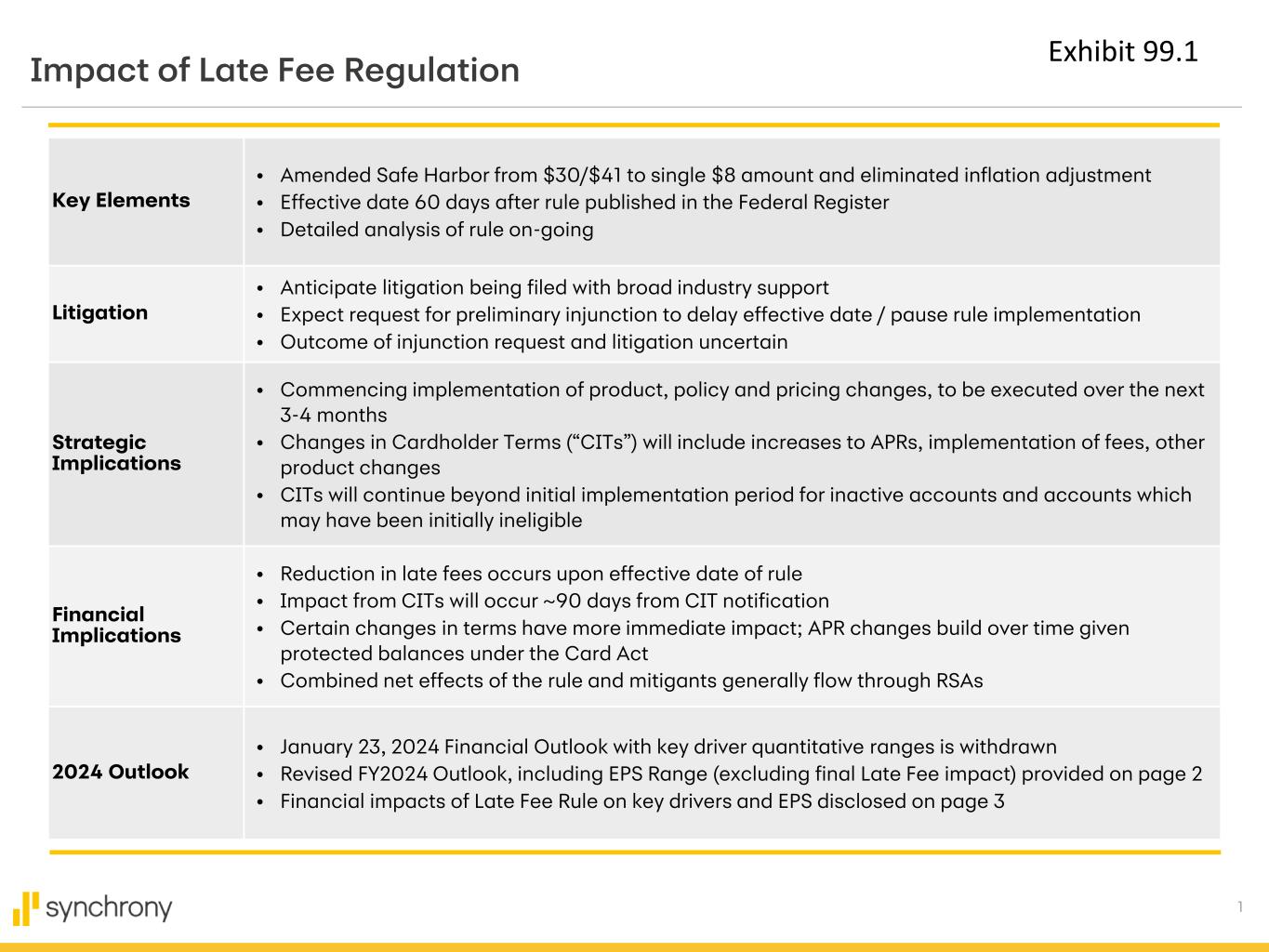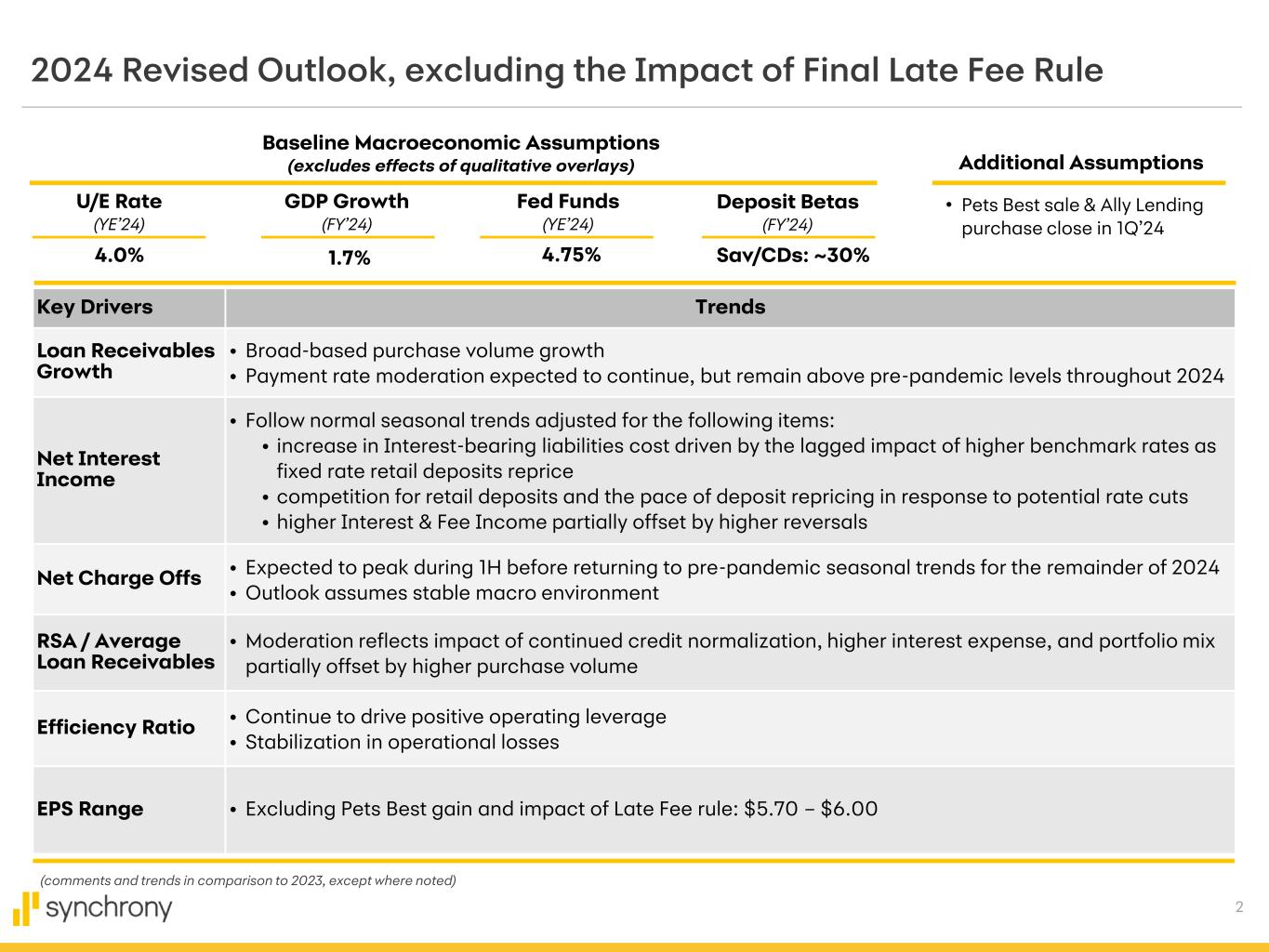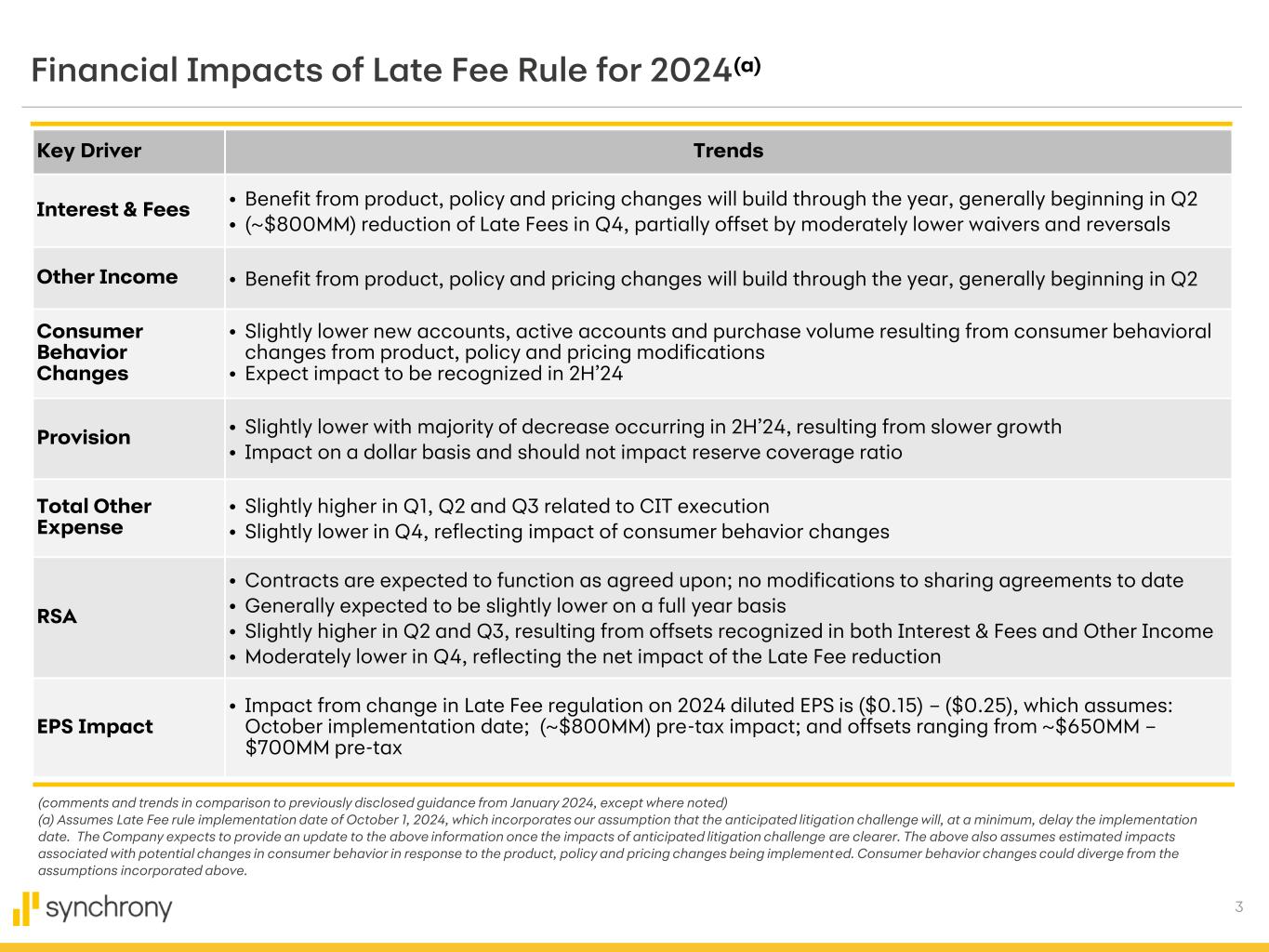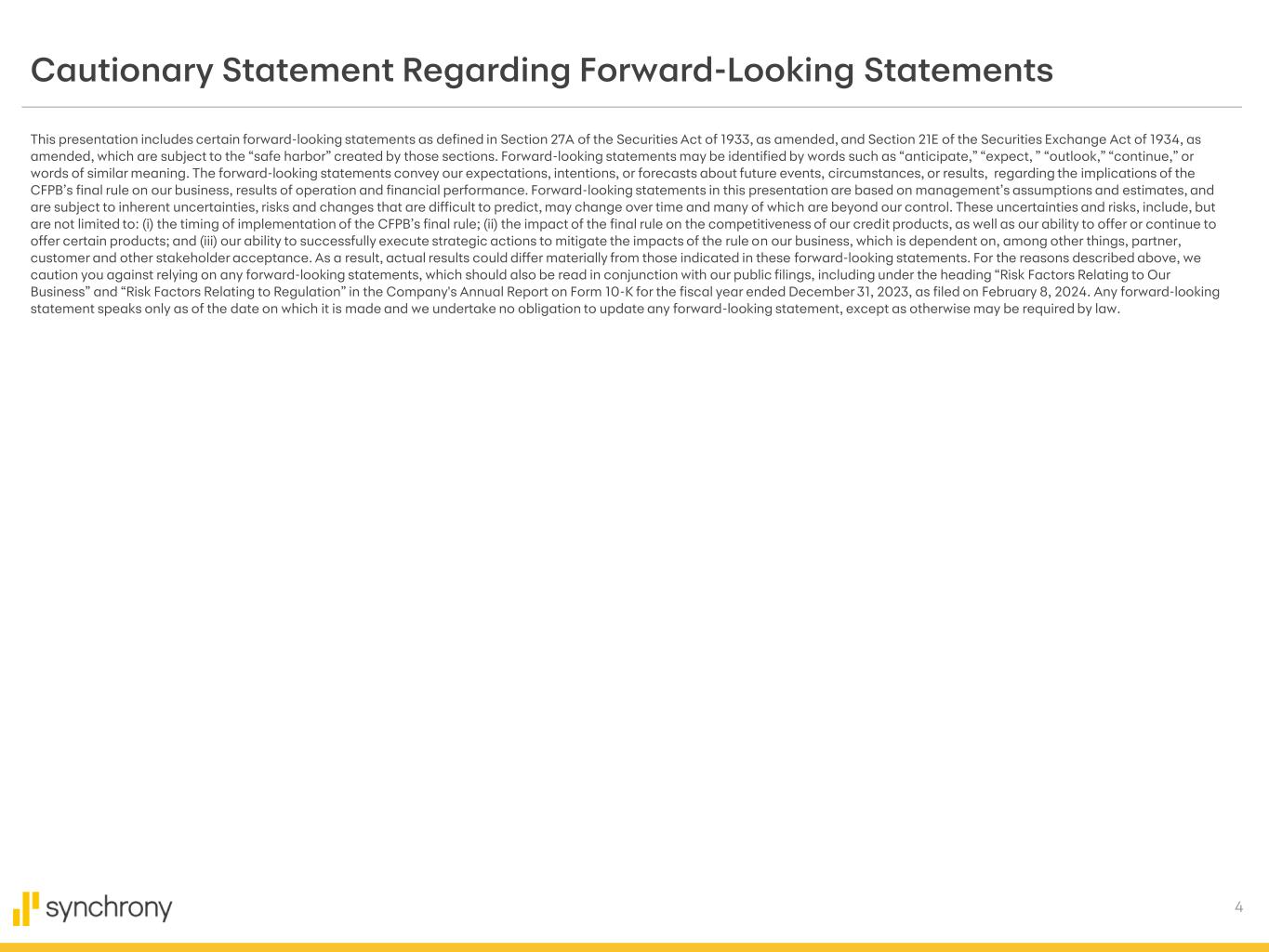
1 Impact of Late Fee Regulation Key Elements • Amended Safe Harbor from $30/$41 to single $8 amount and eliminated inflation adjustment • Effective date 60 days after rule published in the Federal Register • Detailed analysis of rule on-going Litigation • Anticipate litigation being filed with broad industry support • Expect request for preliminary injunction to delay effective date / pause rule implementation • Outcome of injunction request and litigation uncertain Strategic Implications • Commencing implementation of product, policy and pricing changes, to be executed over the next 3-4 months • Changes in Cardholder Terms (“CITs”) will include increases to APRs, implementation of fees, other product changes • CITs will continue beyond initial implementation period for inactive accounts and accounts which may have been initially ineligible Financial Implications • Reduction in late fees occurs upon effective date of rule • Impact from CITs will occur ~90 days from CIT notification • Certain changes in terms have more immediate impact; APR changes build over time given protected balances under the Card Act • Combined net effects of the rule and mitigants generally flow through RSAs 2024 Outlook • January 23, 2024 Financial Outlook with key driver quantitative ranges is withdrawn • Revised FY2024 Outlook, including EPS Range (excluding final Late Fee impact) provided on page 2 • Financial impacts of Late Fee Rule on key drivers and EPS disclosed on page 3 Exhibit 99.1

2 2024 Revised Outlook, excluding the Impact of Final Late Fee Rule Key Drivers Trends Loan Receivables Growth • Broad-based purchase volume growth • Payment rate moderation expected to continue, but remain above pre-pandemic levels throughout 2024 Net Interest Income • Follow normal seasonal trends adjusted for the following items: • increase in Interest-bearing liabilities cost driven by the lagged impact of higher benchmark rates as fixed rate retail deposits reprice • competition for retail deposits and the pace of deposit repricing in response to potential rate cuts • higher Interest & Fee Income partially offset by higher reversals Net Charge Offs • Expected to peak during 1H before returning to pre-pandemic seasonal trends for the remainder of 2024 • Outlook assumes stable macro environment RSA / Average Loan Receivables • Moderation reflects impact of continued credit normalization, higher interest expense, and portfolio mix partially offset by higher purchase volume Efficiency Ratio • Continue to drive positive operating leverage • Stabilization in operational losses EPS Range • Excluding Pets Best gain and impact of Late Fee rule: $5.70 – $6.00 Baseline Macroeconomic Assumptions (excludes effects of qualitative overlays) U/E Rate (YE’24) Fed Funds (YE’24) Deposit Betas (FY’24) 4.0% 4.75% Sav/CDs: ~30% Additional Assumptions • Pets Best sale & Ally Lending purchase close in 1Q’24 GDP Growth (FY’24) 1.7% (comments and trends in comparison to 2023, except where noted)

3 Financial Impacts of Late Fee Rule for 2024(a) Key Driver Trends Interest & Fees • Benefit from product, policy and pricing changes will build through the year, generally beginning in Q2 • (~$800MM) reduction of Late Fees in Q4, partially offset by moderately lower waivers and reversals Other Income • Benefit from product, policy and pricing changes will build through the year, generally beginning in Q2 Consumer Behavior Changes • Slightly lower new accounts, active accounts and purchase volume resulting from consumer behavioral changes from product, policy and pricing modifications • Expect impact to be recognized in 2H’24 Provision • Slightly lower with majority of decrease occurring in 2H’24, resulting from slower growth • Impact on a dollar basis and should not impact reserve coverage ratio Total Other Expense • Slightly higher in Q1, Q2 and Q3 related to CIT execution • Slightly lower in Q4, reflecting impact of consumer behavior changes RSA • Contracts are expected to function as agreed upon; no modifications to sharing agreements to date • Generally expected to be slightly lower on a full year basis • Slightly higher in Q2 and Q3, resulting from offsets recognized in both Interest & Fees and Other Income • Moderately lower in Q4, reflecting the net impact of the Late Fee reduction EPS Impact • Impact from change in Late Fee regulation on 2024 diluted EPS is ($0.15) – ($0.25), which assumes: October implementation date; (~$800MM) pre-tax impact; and offsets ranging from ~$650MM – $700MM pre-tax (comments and trends in comparison to previously disclosed guidance from January 2024, except where noted) (a) Assumes Late Fee rule implementation date of October 1, 2024, which incorporates our assumption that the anticipated litigation challenge will, at a minimum, delay the implementation date. The Company expects to provide an update to the above information once the impacts of anticipated litigation challenge are clearer. The above also assumes estimated impacts associated with potential changes in consumer behavior in response to the product, policy and pricing changes being implemented. Consumer behavior changes could diverge from the assumptions incorporated above.

4 Cautionary Statement Regarding Forward-Looking Statements This presentation includes certain forward-looking statements as defined in Section 27A of the Securities Act of 1933, as amended, and Section 21E of the Securities Exchange Act of 1934, as amended, which are subject to the “safe harbor” created by those sections. Forward-looking statements may be identified by words such as “anticipate,” “expect, ” “outlook,” “continue,” or words of similar meaning. The forward-looking statements convey our expectations, intentions, or forecasts about future events, circumstances, or results, regarding the implications of the CFPB’s final rule on our business, results of operation and financial performance. Forward-looking statements in this presentation are based on management’s assumptions and estimates, and are subject to inherent uncertainties, risks and changes that are difficult to predict, may change over time and many of which are beyond our control. These uncertainties and risks, include, but are not limited to: (i) the timing of implementation of the CFPB’s final rule; (ii) the impact of the final rule on the competitiveness of our credit products, as well as our ability to offer or continue to offer certain products; and (iii) our ability to successfully execute strategic actions to mitigate the impacts of the rule on our business, which is dependent on, among other things, partner, customer and other stakeholder acceptance. As a result, actual results could differ materially from those indicated in these forward-looking statements. For the reasons described above, we caution you against relying on any forward-looking statements, which should also be read in conjunction with our public filings, including under the heading “Risk Factors Relating to Our Business” and “Risk Factors Relating to Regulation” in the Company's Annual Report on Form 10-K for the fiscal year ended December 31, 2023, as filed on February 8, 2024. Any forward-looking statement speaks only as of the date on which it is made and we undertake no obligation to update any forward-looking statement, except as otherwise may be required by law.